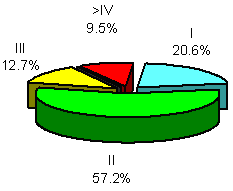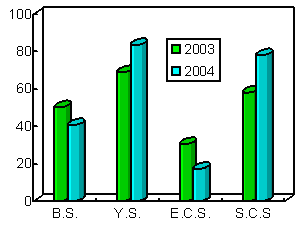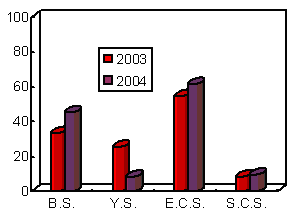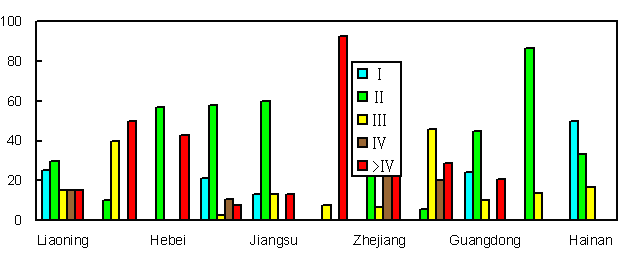
Report On the State
of the Environment In China
2 0 0 4
Marine Environment
General Situation
In 2004, most coastal sea areas of China had good water quality with aggravated pollution in some areas. Water quality in high sea areas remained in good level.
There were 246 coastal monitoring stations in mainland China, 49.6% of them met Grade I ~ II marine water quality standard, similar to that of the previous year; 15.4% of them met Grade Ⅲ standard, 4.4 percentage points lower than that of 2003; 35.0% of them met or inferior to Grade IV standard, 5 percentage points higher than that of 2003.

The percentage of water quality in coastal sea areas of China in 2004
During 2004, of the four major sea areas in China, water quality in the Yellow Sea and South China Sea was good at large with a dominant percentage meeting Grade I ~ II marine water quality standard, 83.4% and 77.8% respectively. There were a 14.7 percentage points higher in the Yellow Sea and 19.8 percentage points higher in the South China Sea compared with that of last year. As to Bohai Sea, this percentage was 40.4%, 9.6 percentage points lower than that of the previous year. 45.3% coastal water of Bohai Sea met or was inferior to Grade IV standard, 12.0 percentage points up compared with that of 2003. The main pollutants were inorganic nitrogen, activated phosphates and petroleum. In East China Sea, there was no Grade I category water, water of Grade II category accounted for 17.2%, 13.2 percentage points lower than that of 2003; water of Grade IV category and worse took up 61.3% of the total, 6.9 percentage points up compared with that of 2003. Pollutions in Bohai Sea and East China Sea presented aggravating trend.

Distribution of Polluted Sea Areas in 2004

Water quality status in Bohai Sea

Water quality status in Yellow Sea

Water quality status in East China Sea

Water quality status in South China Sea

Percentage of Grade I ~ II categories in the four major seas

Percentage of the water worse than Grade IV in the four major seas
(Note: B.S. stands for Bohai Sea; Y.S. for the Yellow Sea; E.C.S. for East China Sea and S.C.S for South China Sea)
In 2004, water quality in coastal sea areas of Guangxi, Hainan, Shandong, Jiangsu and Guangdong provinces was good with water of Grade I ~ II categories accounting for over 68%. Among them, Hainan had the biggest percentage of 50% of Grade I category marine water; followed by Guangdong with 24.1%, Shandong with 21.1% and Jiangsu coastal area with 13.3%. There was no Grade I category marine water in coastal sea waters in Guangxi Province, 86.4% of its marine water fell into Grade II standard. Shanghai and Zhejiang Province had poor marine water quality, with no water of Grade I and Grade II categories and as high as 92.3% of the marine water failed to meet Grade IV standard. There was no Grade I marine water in Zhejiang, Tianjin, Fujian and Hebei offshore areas, but Grade II marine water accounting for 31.1%, 10.0%, 5.7% and 57.1% respectively, while marine water met Grade IV standard and worse took up 62.2%, 50%, 48.6% and 42.9% respectively.

Marine water quality of coastal provinces, autonomous regions and municipalities of China
Red tides: China's coastal sea areas witnessed 96 occurrences of red tides in 2004, 23 less than in 2003. The accumulated area subject to red tide was 26,230 km2, 83.0% higher than that of 2003. Most big red tides occurred in the East China Sea. There were 34 red tides with an area over 100 km2, 16 of which covering an area over 500 km2 and 10 affecting an area close to or over 500km2, all the occurrences were higher than that of 2003. Red tides induced by venomous living beings amounted to more than 20 times with an area of 7,000 km2; the main venomous living beings were Karenia mikimotoi, Phaeocystis pouchetii etc..

The main characteristics of red tides in 2004 were as follows: Bohai Sea─The occurrences of red tides concentrated in June with the frequency same as that of the previous year. Yellow Sea─The first red tide occurred in the last ten days of March, and the peak period was from August to September. The occurrences were 1.5 times higher than that of 2003 and the affecting area twice as big as that of 2003, but all were in small scales. The species of red tides varied with Pyrrophyta as the dominant one. East China Sea─The occurrences of red tides decreased by 37% but the affected area increased by around 45% compared with that of 2003. The affected area was the largest over the past years. The sea area with red tides accounted for 56% of the total area and the accumulated red tide areas took up 68%. The peak period was in May and June during which 25 red tides occurred at coastal areas of Zhejiang Provinces in late May with affected area of 13,000 km2. The biggest red tide appeared in central and southern part of Zhejiang offshore area in early May with an area around 8,000 km2. The dominant algae was Alexandrium sp., a typical organism easy to cause red tide and contains paralytic shellfish toxin. South China Sea─The incidence of red tide was similar to that of 2003, but the accumulated affected area was twice as much. Among them, the red tide induced by Phaeocystis pouchetii near Guang’ao Island of Shantou City in the mid of November spread over 600 km2 of coastal area.
Countermeasures and Actions
【The implementation of 'Blue Bohai Sea Action Plan' 】The three provinces and one municipality bordering Bohai Bay had completed 125 projects (excluding nature reserves project) under the
'Blue Bohai Sea Action Plan' with 87 projects being under construction by the end of 2004, accounting for 47.2% and 32.8% respectively of the total. In the order of 16.39 billion yuan RMB investment had been put in place, taking up 59.3% of the planned total amount Among those completed projects, 51 were in Shandong Province, 22 in Liaoning Province, 30 in Tianjin Municipality and 22 in Hebei Province. As to the projects under construction, 41 were in Shandong Province, 18 in Liaoning, 17 in Tianjin and 11 in Hebei. There were 26 newly completed projects compared with that of the previous year, among them, 11 were in Shandong Province, 10 in Liaoning, 4 in Tianjin and 1 in Hebei.
【Weekly Report on the marine water quality of bathing beaches during summer vacation】The State Environmental Protection Administration (SEPA) continued its efforts in monitoring the water quality of 28 bathing beaches of 16 coastal cities across China from June to September of 2004 and had released 18 issues of
Weekly Report on the Water Quality of Bathing Beaches. 82.4% of the monitored bathing beaches were suitable for swimming.
【Development of marine protected reserves】Ten provincial-level marine protected areas were set up in offshore areas of Liaoning, Shandong, Guangdong and other places in 2004. There had been 90 various marine protected areas by the end of 2004, among them 24 were at national-level. In Shankou Mangroves National Marine Protected Areas of Guangxi Autonomous Region, the areas of mangroves expanded by nearly 8 km2
in comparison to its initial size. Nanji Archipelago National-level Marine Protected Areas also enlarged its central area.
Marine Environment